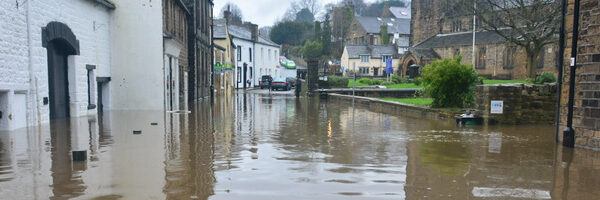Contents
- What is groundwater?
- What is groundwater flooding?
- How to know if you are at risk from groundwater flooding?
- How does groundwater flooding impact development sites?
- How do high levels of groundwater cause sewer flooding?
- Will rising sea levels affect groundwater flood risks?
- How can groundwater flood risks be reduced?
- What is GeoSmart’s GWFlood?
- What are the benefits of GWFlood?
- What is GeoSmart’s GW5 and how can it benefit you?
What is groundwater?
Groundwater is any water which is located in between the pores and cracks of rock and soil beneath the Earth’s surface.
It is an essential source of water in the UK, contributing to approximately 30 percent of England’s public water supply – that’s enough to fill 2500 Olympic-sized swimming pools every day.
During periods of prolonged rainfall, groundwater levels rise as the earth becomes more saturated and water tables (the difference between the ground’s saturated and drier layers) become higher.
Typically, water tables are higher during winter and reach a peak saturation level in spring.
What is groundwater flooding?
Groundwater flooding is responsible for about a quarter of all property and infrastructure risk and can cause a multitude of damages.
These include:
- Disruption to infrastructure such as buried utilities
- Ground stability problems including slope failure, subsidence and sinkholes
- Basement flooding
- Agricultural losses
- Damage to habitats and wildlife
- New springs appearing and sudden movement of water
- Overloaded sewers which can lead to water pollution and service outage
- Leaching of contaminated soil into nearby watercourses from brownfield flooding
- Increased construction costs
- Socio-economic disruption
Climate change could also cause higher rates of groundwater flooding by altering the groundwater recharge season.
Usually running from September through until April, this season denotes the period when surface water sinks through the earth and becomes groundwater.
Growing temperatures and more rainfall could see this season shortened but with increased recharge leading to a rising ground saturation level and heightened flood risk.
How to know if you are at risk from groundwater flooding?
Although it can occur pretty much anywhere, groundwater flooding is most frequent in areas of southern and eastern England, parts of the Cotswolds, East Yorkshire and the Eastern Pennines.
It is particularly prevalent where chalk, sandstone, localised sands or river gravel in the bottom of valleys are present.
If you are a property professional then our groundwater flood risk map (GeoSmart GW5) will inform whether the terrain surrounding your development is susceptible to groundwater emergence.
Another useful source for assessing whether you are at risk of groundwater flooding is through the Environment Agency’s flood risk reports and/or the monthly documents they publish on rainfall and river flow volumes.
How does groundwater flooding impact development sites?
There are multiple ways that groundwater can have an effect on development sites and it is important for developers, planners, architects and anyone involved in a project to understand the risks.
For instance, if a site has an industrial past, groundwater flooding could cause contaminants in the soil to spread and come into contact with the building or people.
Equally, groundwater flooding can have an impact on surface water flood management and cause more damage in the event of heavy rainfall.
Understanding the site’s drainage characteristics and whether a sustainable drainage approach is needed (as determined by your Local Planning Authority) should be considered.
How do high levels of groundwater cause sewer flooding?
When groundwater levels are high, water can access the sewage system by pushing through cracks in pipes, joints, manholes or access chambers.
When this happens, the excess water puts pressure on the sewer’s capacity, increasing the risk of sewer flooding and posing a threat to local communities and businesses.
In an effort to help protect some communities GeoSmart works with a number of water companies to provide alerts to them so they can manage their assets to protect communities.
Will rising sea levels affect groundwater flood risks?
Sea levels are continuing to rise due to the increasing global temperature and a surge of up to 1m could be seen by the end of the century.
As a result, groundwater levels located in coastal and estuary locations will also rise, potentially causing damage to inland infrastructure.
Unexpected consequences could equally be seen if current defence systems become overwhelmed by future groundwater level surges.
How can groundwater flood risks be reduced?
Reducing yours or your client’s susceptibility to groundwater flood risk can be challenging considering it is not widely understood and requires expensive boreholes to measure.
However, there are several measures which can be undertaken to decrease the associated risks.
These include:
- Understanding the impact of groundwater on property via a flood risk map
- Seek improved insurance cover for groundwater risk
- Designing and building property to account for groundwater risk
What is GeoSmart’s GWFlood?
GWFlood is a forecasting system which identifies the risk of groundwater flooding in a specific area and is updated each working day.
Developed from five decades worth of borehole data, hydrogeological expertise and live telemetry feeds, the modelling system produces results by tracking borehole levels, monitoring weather forecasts and mapping risk predictions up to 90 days in advance.
The GWFlood forecast will show you three key predictions. These are:
- The probability of groundwater flooding within 15 days.
- The most likely timescale (less than 15 days) until flooding commences.
- The quickest possible time scale in which flooding might begin.
Delivered across 302 catchment areas across southern and south east England, our standard forecast will be provided to clients as a csv file, ESRI shapefile or PNG image.
What are the benefits of GWFlood?
GWFlood is an advanced system complete with multiple benefits.
Due to its continual updates, GWFlood offers advanced warning of groundwater flooding which facilitates intelligent resilience planning and provides information on when and how long flooding could occur.
Additionally, through the customised mapping and reporting, your assets are taken into consideration when flood risk predictions are generated, a feature that is reinforced by the technical expertise of our in-house hydrogeologists who can advise you how to manage and respond to identified risks.
What is GeoSmart’s GW5 and how can it benefit you?
The GW5 is a map dataset which illustrates the relationship between a specific terrain and groundwater ponding in that area.
Incorporating the new 5m digital terrain model (DTM), GW5 offers a realistic, visual picture of groundwater flood risk present in a specified location.
This dataset comes with several benefits. These include:
- Providing those working in the property, infrastructure and insurance industries with informed choices and confidence in knowing their individual conditions and risks.
- Giving more clarity on groundwater flood risk for property information providers.
- Providing preparation support for emergency response, flood mitigation and land-use planning.
- Producing an informed assessment of the climate change impacts for property asset managers.
- Integration with property assets and insurance risk assessments.
We’re ready when you are…

Contaminated Land
EnviroSmart
EnviroSmart Plus
EnviroSmart Pro

Flood Risk
FloodSmart
FloodSmart Plus
FloodSmart Pro

Sustainable Drainage
SudSmart
SudSmart Plus
SudSmart Pro
CPD Events
Every CPD topic we provide has been produced with property professionals in mind.
Craig Roberts
Hunter Page
Ben Thorns
Solid Digital Marketing Ltd






